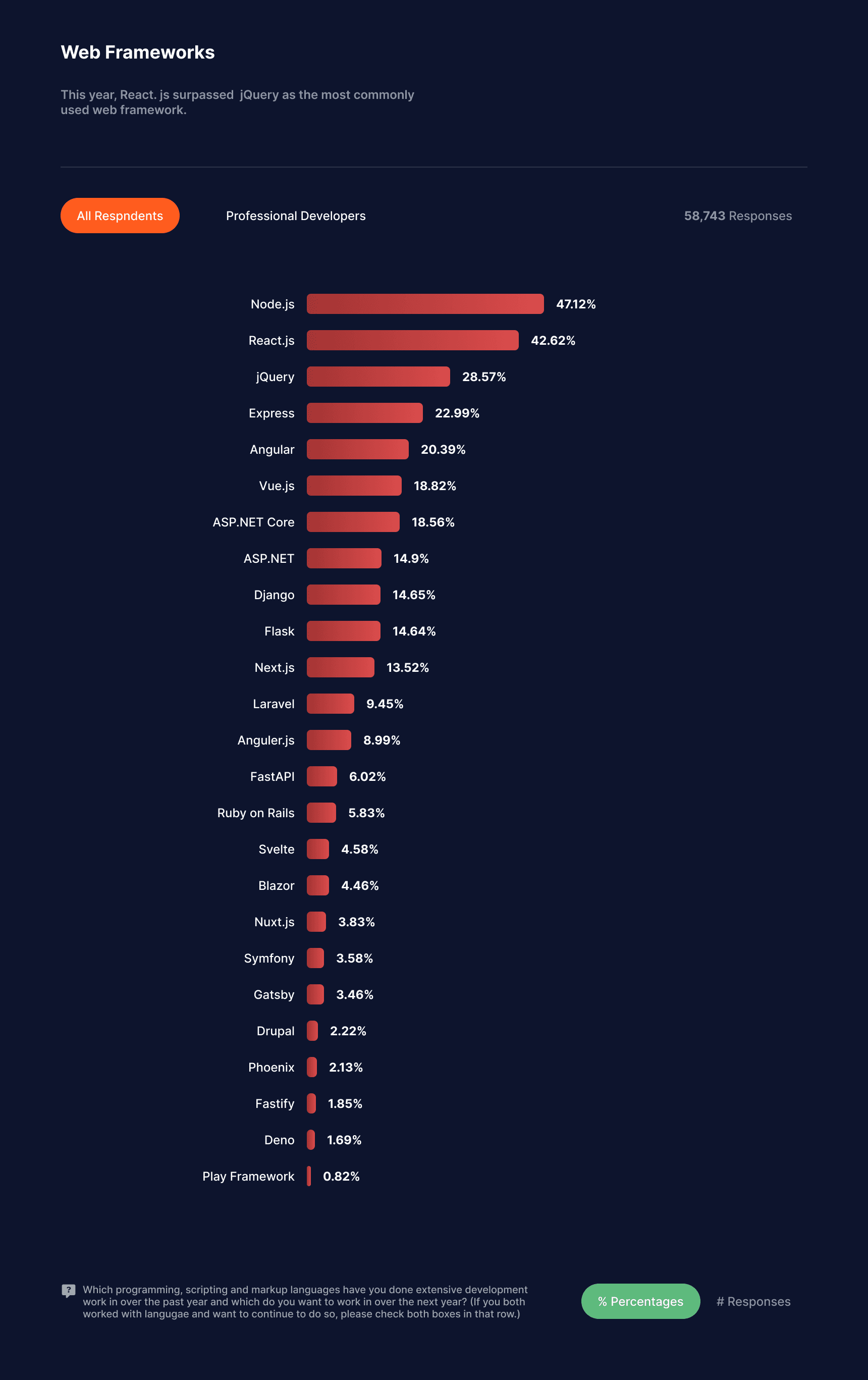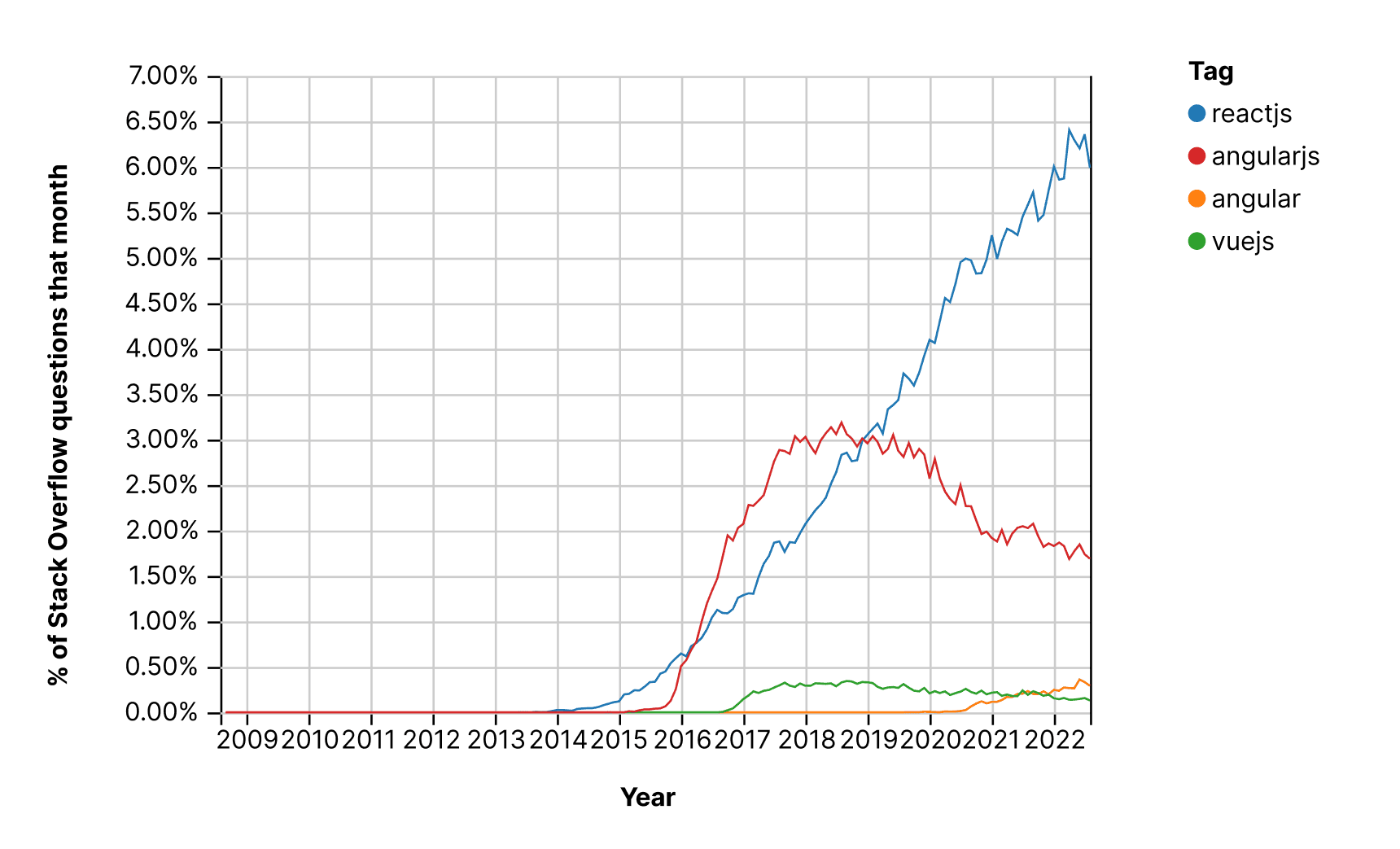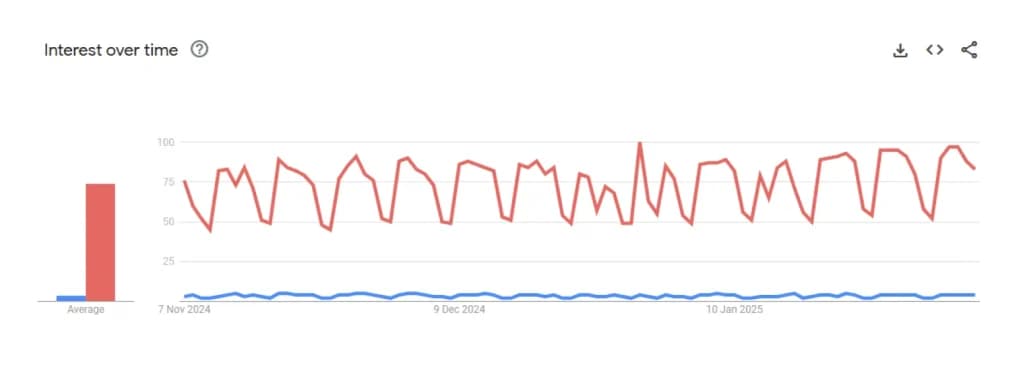React vs Vue – Which JavaScript Framework Is Best for Development?
React vs Vue is the most discussed topic amongst developers, ReactJS is SEO-friendly whereas VueJS comes with a light framework.

React and Vue are two of the most popular front-end development frameworks used by developers these days. As compared to the older frameworks, both of these frameworks have gained a lot of traction, and developers have found it easy to use them. They are one of the top Javascript frameworks. React vs Vue is the most debated topic amongst developers.
Both these frameworks are similar in certain aspects, but still, developers always have this dilemma when deciding which framework to use. Both frameworks are star performers in their own right and are popular in the developer community. But it is essential to choose the right framework for web development to make an application with the best user experience.
This blog is aimed at highlighting the key differences between Vue vs React to help developers and web development agencies make a better decision when choosing either of these frameworks for their web development projects. Although both technologies provide developers with a practical method for creating various Web applications, each has its own optimal use cases and caters to various business requirements.
As per the StackOverflow survey 2022, React.js is the most popular web framework. Among the 67,593 responses, 40% chose React.js, and nearly 19% chose Vue.js.

Table of Contents
What is ReactJS?
React is one of the top JavaScript frameworks that is open source and used to create user interfaces. React simplifies the creation of interactive user interfaces. Create basic views for each state of your application, and React will update and render only the necessary components when your data changes. ReactJS is used to make AJAX calls, handle states, and perform DOM manipulations.
It is basically a JavaScript UI library for building large applications with data that changes over time. It allows the user to create reusable UI components. You can think of the components as the building blocks of your UI. They can be used multiple times within a single component.
ReactJS is used in many web applications for its speed and efficiency. React JS is written in Javascript and can be used on any platform, i.e., on the server, as a client-side library, or even as a desktop application. It is very flexible in terms of implementation and can be used in cross-platform applications.
A componentâs markup is just a function of its state and props. Itâs a very flexible component that can be used for many different purposes. React is a declarative framework, which means that you specify what your component looks like based on what it does, rather than how it does it. This makes your code more predictable and debuggable.
What is VueJS?
Vue.JS is also one of the top JavaScript frameworks for creating user interfaces that is free to use. VueJS allows you to use HTML to describe your applicationâs components. Itâs very similar to ReactJS. You donât need to use any other library or framework to build applications with Vue.js.
VueJS helps the UI to improve responsiveness along with changes. It can extend HTML through directives. It also has built-in directives along with user-defined directives.
History of ReactJS
ReactJS was first created in 2011 by Jordan Walke, a software engineer at Facebook, and later developed by several others. Jordan Walke, under the influence of the HTML library for PHP and XHP, released the first prototype of ReactJS. ReactJS became popular because itâs faster and more efficient than other frameworks.
In 2011, it was deployed on Facebook, and in 2012, it was deployed on Instagram. It was made open source at the 2013 JS Conference. As of March 2016, the library has around 200,000 stars on GitHub. It is maintained by Facebook, Instagram, and a community of individual developers and corporations that make up the React community.
History of VueJS:
VueJS was created in 2014 by Evan You, an independent coder. VueJS is currently the most popular framework in the front-end category on GitHub, with over 198k stars. Evan You, a former Google employee, wanted to build a lighter version with features of Angular, Amber, and others. This led him to create VueJs, which made writing web apps easier, faster, and less stressful!

At present, the Vue.js framework is a preferred choice for a growing number of developers thanks to its ease of use and simplicity. As the name suggests, the framework is a view library that allows you to create and enhance user interfaces. Even though the first source code of VueJS was given in 2013. But, it was released in 2014 February. Unlike other JavaScript frameworks like Angular or React, Vue.js offers a lightweight and simple solution to create interactive interfaces and applications.
Key Features of ReactJs

-
JSX:
JSX is an amalgam of JavaScript and HTML. You can include JavaScript objects inside HTML elements. JSX makes coding easy and understandable.
-
Virtual DOM:
Itâs the most important part of the web, as it divides into modules and executes the code.
-
Performance:
Since ReactJS uses virtual DOM, which updates only the modified parts, it makes DOM run faster.
-
Conditional Statement:
JSX allows you to write a conditional statement. The data in the browser is displayed according to the conditions provided in the JSX.
-
Simplicity:
ReactJS is component-based, which makes the code reusable. It utilizes JSX, a hybrid of HTML and JavaScript.
Key Features of VueJs

-
Virtual DOM:
VueJS uses a virtual DOM, which is also used by other frameworks like RectJS, Ember, etc. In VueJS, the changes are not made directly; instead, a copy of the DOM is created.
-
Animation/Transition:
VueJS provides many ways to apply transitions to HTML elements when they are updated from the DOM.
-
Data Binding:
This feature helps assign values for HTML attributes.
-
Lightweight:
VueJS script is lightweight, and its performance is very fast.
-
Event handling:
v-on is the attribute added to the DOM that listens to the elements in VueJS.
Advantages of ReactJs
- It stands out from the crowd and enables developers to create UI designs that are SEO-friendly.
- Creating a dynamic web application is a lot simpler and easier in ReactJS.
- Performance enhancement is the best in ReactJS due to its virtual DOM. It is completely present in memory and acts as a replica of the websiteâs DOM.
- It is also declarative and composable.
Disadvantages of ReactJs
- Only consider the UI: ReactJS covers only the UI layers of the app, and to complete the project with other tools, we have to choose other components.
- Rapid development: though it adds new features and facilities, the change is much faster. The developer has to update in order to finish the project.
- Migrating data: in ReactJS, it is difficult and time-consuming. If the appâs future is unknown, then there is a chance to drop the idea of migration.
Advantages of VueJs
- Tiny size: AÂ downloadable zip file with the framework that weighs 18 KB. Its lightweight framework, along with its libraries, has a positive effect on UI design.
- Good for unit testing: Unit testing is a Q n A activity. Since it has components, it enables checking the smallest partsâ functionalities.
- Code readability: Since all the components are stored in separate files, the code is easier to read and understand.
Disadvantages of VueJS
- Lack of experts: VueJS is a relatively young technology. The developers are still adjusting and sharpening this framework.
- Lack of support for large-scale projects: Since its popularity is increasing, the demand for support has also increased. But the small team unit is unable to serve the demand.
- Lack of plugins: this is quite hard to believe but true. It has fewer plugins compared to AngularJS and ReactJS.
React Vs Vue
| ReactJS | VueJS | |
| Date of release | May 2013 | February 2014 |
| Approach | JSX (JS Syntax EXt.) | |
| Adopted | Web and mobile applications | Only web-based applications. |
| Speed | Normal | Comparatively faster |
| Library Managed by | Mobx | VueX |
| Backed by | Alibaba and Laravel |
Detailed Comparison of React vs Vue
1. Popularity: React vs Vue:
ReactJS has been increasing in popularity over the past five years. But VueJS has been stable with no impressive growth. It is still in the game. Surprisingly, Vue has users spread almost all over the world, while ReactJS has only a few major countries using it. ReactJS is the clear winner if you compare the number of users between the two. VueJS is just four steps away from ReactJS.

Source:Â Google Trends
2. Community Support in React and Vue:
ReactJS has a fairly large community support, since it is open source, the contributors are also worldwide. It also has more content compared to Vue. In 2021, it had 70% of the votes for community support. It is comparatively more interactive and problem-solving in nature. VueJS has good community support. But there are not many people who have tried Vue. But it is the most liked framework in GITHUB. This says whoever tried it is mostly satisfied and recommends it to others. Also, the VueJS community focuses more on building or creation.
React simplifies the creation of interactive user interfaces. Create basic views for each state of your application, and React will update and render only the necessary components when your data changes.

3. Documentation in React and Vue:
In ReactJS, there is an enormous amount of content. So to document or maintain these contents, it uses JSDoc. JavaScript uses JSDocs as a standard approach for writing code documentation. It also helps with various other tools. This documentation is enough for a medium-level, experienced developer to learn ReactJS. But itâs not so feasible for a person whoâs learning from scratch.
The documentation of VueJS is easy to understand, though itâs not as rich as that of other frameworks. The official documents are more than enough for newbies to get jump-started with learning VueJS and developing web apps.
4. Essential Toolset in ReactJs and VueJs

- Reactide: Reactide is the first version of the React IDE for developing web applications. It helps with component visualization and streamlined configuration.
- React Cosmos: This React dev tool is a complete solution for building reusable components. It focuses on long-term design and component libraries.
- React Sight: The significant tool makes an app appear in a flow chart structure. It doesnât require any setup and enhances speed.
A few examples of the VueJS toolset

- Vuetify is used to beautify the application. It is so simple that even a non-designer can use it to make great designs. It offers over 80 components along with built-in SSR support.
- Axios is ubiquitous, contains TypeScript definitions, and enables cancellation, making it relatively comparable to its predecessor.
- Vue Apollo: GraphQL is responsible for developing the potential of APIS. Through Vue Apollo components, itâs easy to use GraphQL in a quiet declarative manner.
5. Syntax – a big differentiator
- The building view layer in ReactJS is completely dependent on JSX. Reactâs style of combining HTML and CSS into JavaScript lets developers build self-contained UIs. These UI components include view-rendering instructions.
VueJS has HTML templates by default to build the view layer. But it also has JSX as an option. Vueâs separation of concerns (HTML, CSS, and JS) makes its syntax beginner-friendly. HTML templates for VueJS are familiar to web designers. This would make collaboration between developers and designers easy.
6. Component approach
A component is the core building block of ReactJS. Components are pieces of the application that is developed. Components make the task of building UI easier. The components of the UI give you the liberty to work on them individually and merge them with the parent component. The components in React return JSX codes that tell what should be rendered on the screen.
In VueJS, components are used to split and isolate the UI into independent reusable pieces. It can also arrange nested components into a tree. They are similar to how we nest native HTML elements. VueJS components work well with native web components.
7. State management in ReactJS and VueJS
In ReactJS, at a given instance, the value of dynamic properties is represented by the state.
There are four main types of states to manage. There are four: local state, global state, server state, and URL state. Each component in ReactJS has a dynamic data store. There are different ways of handling state management in ReactJS. Popular libraries are Redux, Mobx, or even the native context API, which can get things done. MobX is the simplest option.
In Vue, state management is a self-contained unit with the following parts: The state, the source of truth that drives the app. The view is a declarative representation of the state. The actions are the ways the state could change in response to inputs from the user through the view.
Vuex is the official library for state management, but it is tough for beginners. The Store behaves like the centre of all operations in a Vuex application. Itâs a reactive container that holds the state of your entire application along with the functions required to read from and write to this state set. Data or methods defined in a store are universal, I.e can access them from anywhere in the Vue app.
8. Productivity and Development Speed in Angular and ReactJS
ReactJS demands knowledge of choosing a router system, configuration, and a higher problem-solving attitude. ReactJS works best for a team with experience that has worked on several projects. It is also a great option for developing primary apps or features with a moderate level of experience.
VueJS is best for creating apps at a faster speed. Along with tools like Bit, Vue-dev tools, and VueJS loader web packs, it is much easier to create SFCs (single file components), This makes workflow easy and creates opportunities for development.
9. The Learning Curve
- ReactJS: ReactJS is easy to learn for those who have tried hands-on Javascript. An understanding of API architecture structures and the data flow of Javascript will help a lot. Due to the shorter learning curve, itâs easy to team up with developers of any background (beginners to experienced). The materials needed to study or learn ReactJS are also easily available on the market. But versions after 16.0 are more advanced and may cause trouble for new developers.
- VueJS: VueJS is the easiest Javascript framework; it is so easy that it can be learned within a few hours or less than a week. With basic knowledge of ES6 functions and a primary understanding of Javascript, the official documentation is more than enough to study and learn the language and develop web apps.
Knowledge vs Time Graph

10. Mobile App Solutions in ReactJS and VueJS
ReactJS has high app performance and cross-platform development with React Native. This allows for the creation of apps for mobile platforms (native iOS and Android), so businesses can reach a wider audience of users without exceeding the budget. There is an ample amount of ReactJS specialists in the market. So, setting up a team is not difficult.
The VueJS framework primarily focuses on single-page applications and UI design. The clear separation between javascript, HTML templates, and styling makes it popular among developers.
11. Talent Availability and Hiring Demand
Since ReactJS is quite an older and well-known framework, there are more developers in the community, and the demand is also increasing. Since the javascript developers are keen to even get into web development. Thus, hiring for ReactJS is a much easier process. The average ReactJS developer earns around $34 to $100 based on skills and experience. Sometimes earnings vary from country to country.
VueJS still has potential. But it has relatively fewer experts or professionals ready to hit the ground. Though learning the basics of VueJS is still easy, Since these frameworks have a simple architecture and flexibility in features, Companies consider extending their team rather than hiring freelancers. It takes 4-5 VueJS developers to build a small project. The bigger project requires a team minimum of five, with one or two experts.
12. Testing in ReactJS and VueJS
ReactJS has test runners; these tools make testing a smooth process. Some of the test runners are: It can identify the real browser environment, expensive manipulation of functions Etc.
VueJS is more like a new rising celebrity in the market. It has similar tools to ReactJS but no advanced toolset. The VueJS testing library and VueJS testing utilities make debugging and refactoring a breeze. It has faster feedback loops due to CI/CD and hot reloading features.
13. Performance in React Vs Vue
Any change in the ReactJS state would trigger the whole component subtree to get rendered. Replacing the entire state with a new object takes less time in ReactJS. The startup performance in ReactJS is a bit faster. It is also faster at creating tables with huge amounts of data and numerous simple cells. But, in ReactJS, we have to either manually update shouldComponentUpdate or use pureRenderMixin to optimize performance by default.
VueJs is by far one of the best for any type of in-place data mutation. The number of triggers is the same as the number of changes. If the whole state is replaced by fresh objects, it takes a bit more time.
But VueJS is best for developing apps with a lot of components and complex markup. Itâs also notable that its runtime performance is optimized by default.
14. Architecture: ReactJS and VueJS

ReactJS serves the application’s (appâs) view layer. Components in ReactJS work as functions that render the underlying user interface as the data changes. The internal architecture of ReactJS supports a constant interaction between the usersâ actions and the state of the application components. ReactJS is a great option to build apps with limited functionality. But to build real-world apps, you are dependent on external libraries and other technologies.

On the other hand VueJS, on the other hand, has a view model. The view and model parts are interconnected (two-way connection). The architecture of VueJS is abstracted into two parts: filters and directives. Although VueJS is not a full-blown framework, it operates in a view layer pattern, and the handling of application development is made flexible and simple.
15. Scalability – VueJs Vs ReactJs
If ReactJs apps are made up of only Javascript, there are traditional ways of scaling it up. But as we know, it is most viable to make a scalable UI design with virtual DOMs and component reusability.
Since VueJS has a light architecture, it is preferred for making a small-time application. But it offers some amount of scalability due to its dynamic nature. It can be possible by overriding code through the use of web packs and Mixin elements.
When to choose reactJS?
- Want more and more libraries to help you.
- Developing a scalable application without much testing and debugging
- Building a complex application
- Crazy about creating your own video streaming and media platforms.
When to choose Vuejs?
- Building progressive web apps or SPAs (single-page applications).
- have less time to execute your project.
- You need a better separation of concerns in your project.
- Looking forward to extending the functionality of existing applications.
Popular React js Website Examples:

- Asana
- Netflix
- Codecademy
- Yahoo mail
- New York Times
- Atlassian
- DropBox
- Airbnb
Popular Vue js Websites Examples:

- Xiaomi
- The Motley Fool
- Trivago
- Grammarly
- Apple
- Gitlab
- Behance
- Nintendo
- BMW
- Up-work
React vs Vue: Which Is Better?
ReactJS and VueJS both have unique use cases. There is no clear winner. But it is best for you to select based on one of your interests or requirements.
If you want to build advanced, user-friendly web and mobile applications, then SolGuruz is the leading Web development agency in India, with timely delivery by their expert ReactJs developers and expert VueJs developers. Let us be your web development partners because we are web development experts.
FAQs
1. Which JavaScript framework should I pick for the next project?
Vue can be chosen since it is a logical choice for all your projects. React can be chosen since it works better for creating static websites.
2. What are some of the perks of using ReactJS over VueJS?
Since ReactJS provides a development framework that supports cross-platform apps, it is a better option for mobile development.
3. What are some of the drawbacks of using ReactJS over VueJS?
Reactâs CLI performs slightly worse than Vueâs. You cannot modify your project while it is being generated, and you could only use a single-page app template.
4. Which is the top React and Vue development company in India?
SolGuruz is a top ReactJs development company and VueJS development company in India committed to helping customers meet their business goals and achieve industry success with the help of our top web development experts. So, if you are looking to expand your business, then hire ReactJS developers and hire VueJS developers from SolGuruz.
Choose Between React and Vue
SolGuruz helps you decide whether React or Vue fits your project goals with our expert comparison and guidance.

Strict NDA

Trusted by Startups & Enterprises Worldwide

Flexible Engagement Models

1 Week Risk-Free Trial
Give us a call now!

+1 (724) 577-7737


